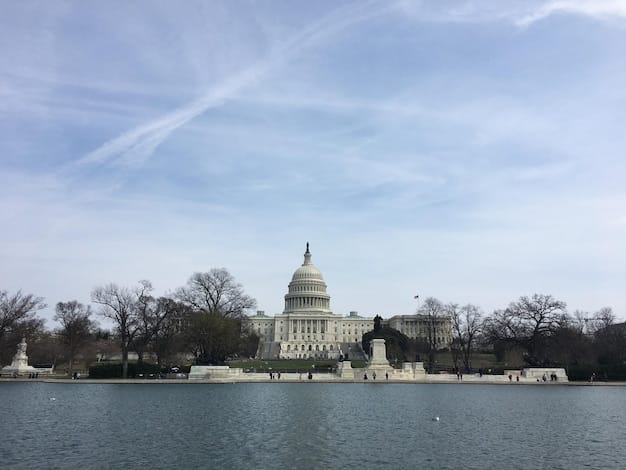Student Loan Forgiveness: Impact on US Debt and Taxpayers

Anúncios
The projected impact of the student loan forgiveness program on the US national debt and taxpayers is complex, involving potential increases in the national debt and varied effects on different taxpayer groups.
The debate surrounding student loan forgiveness continues, with significant implications for the US economy. Understanding what is the projected impact of the student loan forgiveness program on the US national debt and taxpayers involves examining both the potential benefits and drawbacks of such policies.
Anúncios
Understanding Student Loan Forgiveness
Student loan forgiveness programs aim to alleviate the burden of student debt for borrowers, offering a chance to have a portion or all of their loans discharged. However, the economic implications of these programs are a subject of intense discussion and analysis.
Types of Student Loan Forgiveness Programs
Several types of student loan forgiveness programs exist, each with its own eligibility criteria and terms. Understanding these differences is crucial for assessing their aggregate impact.
Anúncios
- Public Service Loan Forgiveness (PSLF): This program offers forgiveness to borrowers employed by government or non-profit organizations after they’ve made 120 qualifying payments.
- Income-Driven Repayment (IDR) Forgiveness: IDR plans offer forgiveness after 20 or 25 years of qualifying payments, depending on the specific plan.
- Other Targeted Forgiveness Programs: These include programs for teachers, nurses, and those with disabilities, each with specific requirements.
The implementation of these programs varies, affecting both the borrowers and the broader economy. Each program carries different levels of potential impact on the national debt and taxpayers.

The Impact on the National Debt
One of the primary concerns regarding student loan forgiveness is its potential impact on the US national debt. Forgiving student loans essentially adds to the national debt, as the government is foregoing expected future payments.
How Forgiveness Adds to the Debt
When student loans are forgiven, the government absorbs the cost, which is then added to the national debt. This is because the forgiven amount is no longer an asset on the government’s balance sheet.
The Congressional Budget Office (CBO) has estimated that large-scale student loan forgiveness could add hundreds of billions of dollars to the national debt over the next decade. The exact amount depends on the scope and design of the forgiveness program.
Long-Term Effects on the Economy
While the immediate effect is an increase in the national debt, some economists argue that student loan forgiveness could stimulate the economy in the long run. By freeing up borrowers’ disposable income, it could lead to increased consumer spending and investment.
However, there are also concerns that increasing the national debt could lead to higher interest rates and reduced government spending in other areas, potentially offsetting any economic benefits.
The long-term repercussions of forgiving student loans could affect economic growth, inflation rates, and government spending priorities. Accurate forecasting involves sophisticated economic modeling and careful consideration of multiple variables.
Effects on Taxpayers
The impact of student loan forgiveness on taxpayers is multifaceted. While it may provide relief to borrowers, it also shifts the financial burden to taxpayers who did not take out student loans themselves.

Who Pays for Loan Forgiveness?
Ultimately, the cost of student loan forgiveness is borne by taxpayers. This includes both those who directly benefit from the program and those who do not.
Taxpayers fund the government programs that forgive student loans. This can lead to debates about fairness and whether it is equitable to ask those who did not attend college or have already paid off their loans to foot the bill for others.
Potential Benefits for Taxpayers
Some argue that student loan forgiveness can indirectly benefit taxpayers by boosting the economy. As borrowers have more disposable income, they may spend more, leading to increased economic activity and tax revenues.
- Increased Consumer Spending: Forgiveness frees up funds for consumption.
- Higher Tax Revenues: Economic growth can lead to increased tax collections.
- Reduced Default Rates: Lower defaults mean fewer losses for the government.
However, these potential benefits are subject to debate, and their magnitude can vary depending on the economic conditions and the specifics of the forgiveness program.
Economic Stimulus vs. Debt Burden
One of the central debates surrounding student loan forgiveness is whether it acts as an economic stimulus or simply adds to the national debt burden. This depends on various factors, including the size of the forgiveness, how it is implemented, and the overall economic climate.
Arguments for Economic Stimulus
Proponents of student loan forgiveness argue that it can stimulate the economy by freeing up borrowers’ disposable income. This can lead to increased consumer spending, investment, and job creation.
Additionally, some studies suggest that reducing student loan debt can improve borrowers’ credit scores, making it easier for them to access mortgages, auto loans, and other forms of credit. This can further boost economic activity.
Arguments Against Economic Stimulus
Critics of student loan forgiveness argue that it is a poorly targeted form of economic stimulus. They contend that it primarily benefits higher-income individuals who are more likely to have student loan debt.
Furthermore, some economists argue that forgiving student loans can create a moral hazard, encouraging future borrowers to take on excessive debt with the expectation that it will eventually be forgiven.
The true economic impact may depend on whether the forgiven funds are spent or saved and what sectors of the economy benefit most. Understanding these dynamics is crucial for projecting net economic effects.
Alternative Solutions and Mitigation Strategies
Given the potential downsides of large-scale student loan forgiveness, policymakers have explored alternative solutions and mitigation strategies to address the student debt crisis. These include reforms to the student loan system, targeted relief measures, and income-driven repayment plans.
Reforming the Student Loan System
One approach is to reform the student loan system to prevent future debt crises. This could involve measures such as:
- Capping Interest Rates: Reducing the cost of borrowing for students.
- Increasing College Affordability: Lowering tuition costs and fees.
- Improving Loan Counseling: Helping students make informed borrowing decisions.
By making higher education more accessible and affordable, policymakers can reduce the need for future loan forgiveness programs.
Targeted Relief Measures
Another approach is to provide targeted relief to specific groups of borrowers who are struggling the most. This could include:
Offering forgiveness to borrowers in certain professions, such as teachers and nurses, who provide valuable public services. Providing additional assistance to low-income borrowers who are at risk of default.
Through careful targeting, relief efforts can be directed to those who need it most, maximizing the impact of the program while minimizing the cost to taxpayers.
Alternative strategies can involve refining eligibility standards or creating hybrid solutions that balance forgiveness with debt management programs.
Long-Term Projections and Uncertainties
Projecting the long-term impact of student loan forgiveness on the US national debt and taxpayers is challenging due to various uncertainties. These include future economic conditions, changes in government policies, and the behavior of borrowers.
Economic Conditions
Future economic conditions can significantly impact the effectiveness and cost of student loan forgiveness programs. A strong economy can boost tax revenues, making it easier to absorb the cost of forgiveness, while a weak economy can exacerbate the negative effects.
Changes in economic variables such as inflation rates, interest rates, and unemployment levels can affect both the costs and benefits of student loan forgiveness.
Changes in Government Policies
Changes in government policies can also affect the long-term impact of student loan forgiveness. Future administrations may choose to expand, modify, or repeal existing forgiveness programs, leading to significant changes in their cost and effectiveness.
Similarly, future laws and regulations related to higher education funding, student loan servicing, and consumer protection can all have an impact on the student debt crisis and the need for forgiveness programs.
Government agencies may implement new guidelines or auditing procedures that change how student loan forgiveness is administered and accounted for.
| Key Point | Brief Description |
|---|---|
| 💰 National Debt Impact | Forgiveness adds significantly to the national debt. |
| 🧑🤝🧑 Taxpayer Burden | Taxpayers ultimately bear the cost of loan forgiveness. |
| 🚀 Economic Stimulus? | Potential stimulus through increased spending. |
| 💡 Alternative Solutions | Reforms and targeted relief are possible alternatives. |
FAQ
▼
When student loans are forgiven, the government absorbs the cost, which increases the national debt as it foregoes future payments.
▼
The cost of student loan forgiveness is ultimately borne by taxpayers through increased taxes or reduced government spending elsewhere.
▼
Proponents argue it can boost the economy by freeing up borrowers’ income, leading to increased spending and investment.
▼
Alternative solutions include reforming the student loan system, targeted relief measures, and income-driven repayment plans.
▼
Uncertainties include future economic conditions, changes in government policies, and the behavioral responses of borrowers.
Conclusion
In summary, what is the projected impact of the student loan forgiveness program on the US national debt and taxpayers, involves a complex interplay of economic factors and policy decisions. While it may provide relief to borrowers, it also carries significant financial implications for the nation’s debt burden and the broader economy.





